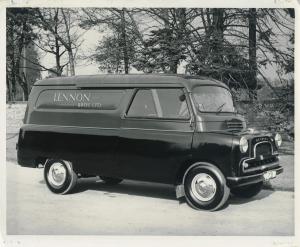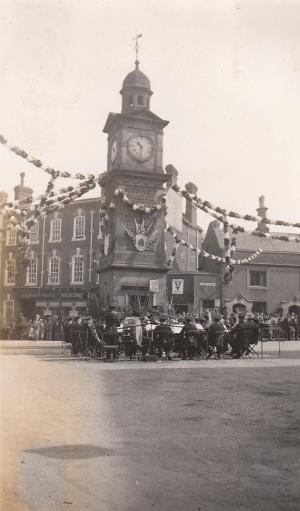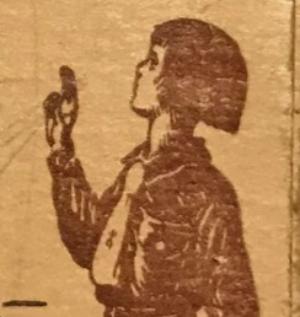Blog - Rugby Art Gallery & Museum
Measuring just 12 mm by 10 mm, this tiny cornelian gemstone is engraved with Methe, the personification of drunkenness in Greek mythology. You can just see the tiny stone in the left hand corner of the display case shown. Methe is raising a vessel as though about to drink from it, while a palm branch lies before her, symbolising triumph over intoxication. It is one of three similar...
Joe Parriss's 1945 diary To mark the 80th anniversary of VE Day - the end of the war in Europe on 8th May - this month’s featured object is the personal diary of Joseph (Joe) Parriss (1862-1951), from the year 1945. The diary offers a glimpse into Joe's day-to-day life during the final year of the Second World War. His entries often note the weather and local outings but it’s...
This month’s object of the month is featured in our current local history display Picturing Rugby. Matchbox covers appeared in the early 19th century as way of protecting cardboard or wooden matchboxes. As a frequently used item, boxes were easily damaged to the point where they couldn’t be used for striking matches. More ornate covers, owned by the wealthy, were made of silver,...
This plaque commemorates the first test run of the jet-propelled engine at British Thomson Houston in Rugby in April 1937. It was unveiled in 1987 by the inventor, Sir Frank Whittle (1907-1996), to mark the 50th anniversary of the test. It was originally on the wall of Building 86/86a at the site. As a young man he joined the RAF and was recommended for officer training in 1926. During his...

March's object of the month is this black and white photograph of a van owned by Lennon Bros Ltd., who were a local firm of tobacconists. The Lennon family moved to Rugby in 1904. In 1911, the family lived at “The Globe Hotel” on Railway Terrace. One of the partners of Lennon Bros. Ltd., Ernest Patrick Lennon (1889-1965), was also a member of the Borough Council between 1938-1961....
This blue plaque is from Richard Henry Wood’s former residence on Little Church Street in Rugby where he lived from 1874 to 1894. Wood was an important local figure in the town and a generous benefactor, most noted for his large contribution to the Hospital of St Cross. He also founded the town’s first public library. Born in Manchester in February 1820, he became a stockbroker and a business...
2000.353.18 For January’s object of the month we look back at some wintery weather with a photograph of the Oxford Canal near Hillmorton Locks taken 42 years ago in January 1982. It shows large chunks of broken ice on the canal’s surface. Many boats had been left ice-bound by the cold weather. The photograph was taken by Joseph Hogg who worked on the canals for many years. In...
Hiltons Garage was on North Street in Rugby from 1903 to the 1960s. Originally started by George Hilton as a cycle repair shop, it expanded as the motoring public needed vehicle servicing along with petrol pumps by the roadside. This leather keyring was given to customers with the keys to their new car. The large site, which included lock ups, service areas and a sales floor, was...
This shield was presented to the Borough of Rugby by the Lords Commissioners of the Admiralty to commemorate the adoption of the HMS Keppel by the Borough during Warship Week. During the Second World War, cities, towns and villages organised Warship Weeks to raise money to meet the cost of providing a particular naval ship. The scheme was introduced by the National War Savings Committee....
We are very lucky to have a dynamic and flexible space which is mainly due to our panelock wall system. The system works with the walls hanging from a metal track, allowing them to move across the whole gallery space and locking in all different ways to enable us to adapt and change the look and feel of the exhibitions. For some shows like the Rugby Open we need maximum wall space. The Gallery...
Birch Rod 2004.371 This birch rod was owned and used by Dr Thomas Arnold (1795-1842). Dr Arnold was the renowned headmaster at Rugby School from 1828-1842. He reformed the school and increased intake of pupils by 100 during his time as headmaster. He was immortalised in the novel ‘Tom Brown School Days’ written by Thomas Hughes in 1857. The birch rod, made up of a bundle of long...
This month’s object of the month is a cigarette photocard featuring British Thomson- Houston (BTH) RUFC team. It was produced in 1936 by the Ardath Tobacco Company. It is number 8 (of 110) in Series E ‘Midlands Football Teams’ produced by the company. Also in the same series was the BTH Football Club. On the reverse of the card are listed the names of club members. The photograph was...
This month’s object of the month is the Mayor’s Journal for Mayor Councillor F.J. Press, J.P for the year 1953-1954 Frederick James Press (1909-1964) was Rugby's youngest ever Mayor, aged 44. His wife was Elsie Winifred Mullock (1909-1997). They had two sons. The journal was bought at a postcard fair in Birmingham before being donated to the museum last year. It contains many photographs,...
This Girl Guide shirt belonged to Nancy Keightly (nee Beere) and dates from the 1920s. It is currently on display in our Join Our Club exhibition. The Scout movement was founded by Robert Baden-Powell in 1908. It is the world's largest voluntary organisation for boys and girls. The Girl Guides was founded by Baden-Powell and his sister Agnes in 1910. The aim of the Girl Guides is to help...
To mark the Coronation of King Charles III this month’s object of the month is a souvenir from the last King’s coronation in 1937. This small tin was produced by Oxo as a memento for the Coronation of King George VI. It features a double portrait of the new King and royal consort Elizabeth. It originally held 6 Oxo cubes and has a slit along the lid for it to be re-used as a...
April's object of the month is a blue bowler hat worn by football supporters on 30th April 1983, when VS Rugby won the FA Vase after defeating Halesowen Town in the Wembley Stadium final. The only goal of the game was scored by Ian Crawley. The bowler hats found their way to the victorious players as they celebrated on the famous turf and shared their success with several...
For Home and Country Women’s Institute Badge The Women's Institute started in Canada in 1897. The first Women’s Institute group in the UK was set up in 1915 to help the war effort during the First World War. Members often organised activities such as country walks and tea parties to help keep evacuee children occupied and entertained. Today their purpose is bringing women together,...
Our object of the month for February is featured in our current social history exhibition Join Our Club. This poster advertises the BTH (British Thomson-Houston Co. Ltd.) Foremen’s Association St Valentine’s Dance on Thursday 14th February 1946 in the Co-Operative Hall, Chapel Street, Rugby. British Thompson Houston was established in Rugby in 1902. Rugby was chosen as their first UK site...

This Christmas card features a black and white drawing of the Clock Tower and the Royal George Hotel and dates from the 1950s It shows the Market Place before it was pedestrianised. On the back is printed: 'One of the last views of the Royal George Hotel, the oldest licensed house in the town; at one time known as the 'Wheatsheaf', its name was later changed to 'The George and...

This Brownie Guide Test Card belonged to Joy Collet of the Crick Brownie pack who joined the pack in July 1935. The front of the card features a brown owl sitting in a tree and a Brownie sitting on a toadstool looking up at it. Written on the front is 'We're the Brownies, Here's our aim, Lend a hand, And play the game'. The inside of the card details the enrolment ceremony for a new...
Showing 1 to 20 of 35 entries.